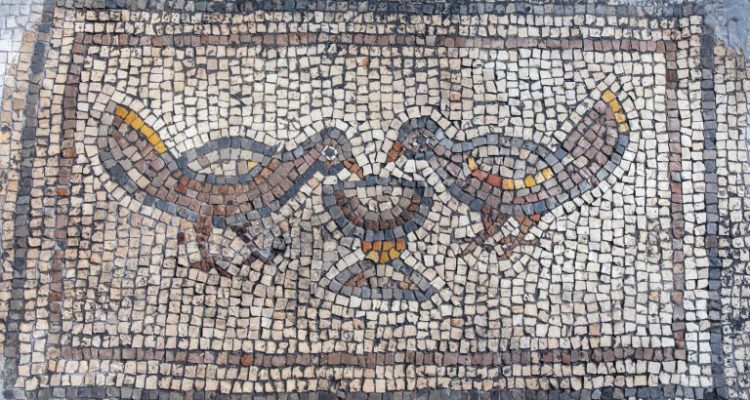Israeli archaeologists uncover and preserve a remarkable mosaic showing what could be the Feeding the Multitude incident from the Gospels.
By Israel21c Staff
A well-preserved mosaic including pictures of baskets with loaves and fish was exposed by archaeologists in the “Burnt Church” of Hippos overlooking the Sea of Galilee from the east.
The depictions in the mosaic, along with the location of the church, immediately raise a connection to Jesus’ Feeding the Multitude event described in all four Gospels.
“There can certainly be different explanations to the descriptions of loaves and fish in the mosaic, but you cannot ignore the similarity to the description in the New Testament: for example, from the fact that the New Testament has a description of five loaves in a basket or the two fish depicted in the apse, as we find in the mosaic,” said Michael Eisenberg, head of the multinational excavation team in Hippos on behalf of the Institute of Archaeology at the University of Haifa.
The fifth-century Church of the Multiplication, on the northwest of the Sea of Galilee, is where the event took place according to the early Christian tradition. Eisenberg says that a careful reading of the Gospels indicates it could have taken place north of Hippos.
“There is no doubt that the local community was well familiar with the two miracles of Feeding the Multitude and perhaps knew their estimated locations better than us. The assumption that the artisan or the persons who ordered the work wanted to create an affinity to a miracle which took place nearby must be logical,” Eisenberg said.
Hippos, now located within Israel’s Hippos National Park, was the central city in the region during Roman and Byzantine times. The ancient city has been excavated over the past 20 years.
The recently exposed Burnt Church, dating from the second half of the fifth to early sixth century CE, was probably burned down during the Sasanian conquest in the early seventh century. The fire caused the church’s roof mosaic floor to collapse on top of the mosaic, covering it with a protective layer of ash.
The colorful mosaic includes geometric patterns and depictions of birds, fish and fruit along with 12 baskets, some containing loaves.





